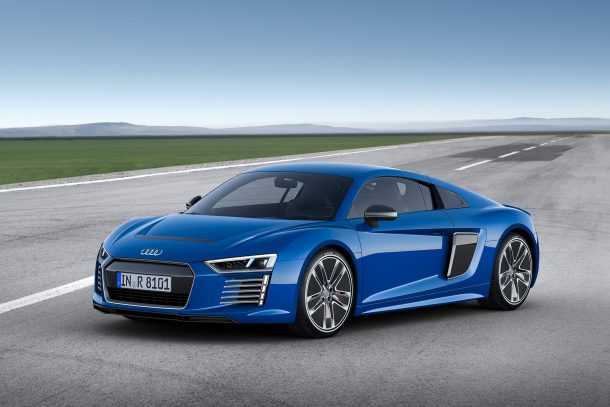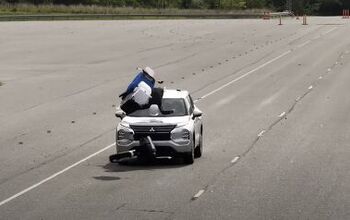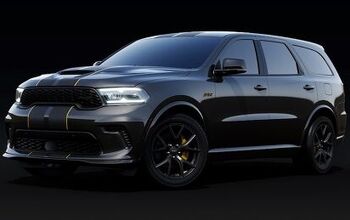Audi R8 to Be Reborn As EV Hypercar by 2022: Report

Unverified industry rumors claim Audi has no intention of bringing back the R8 for a third generation. The problem is deeply rooted in stagnating sales and further exacerbated by tightening emissions standards and Volkswagen Group’s new role as an environmentally conscious manufacturer. However, new reports indicate the brand’s flagship supercar will see new life as a cutting-edge electronic menace. A real Max Headroom, if you’ll forgive the incredibly dated reference.
The R8 has already done some time as an EV. Back in 2015, the German brand launched an e-tron variant that swapped the model’s stellar V10 for an all-electric drivetrain. But the project was short lived. After years of teasing and endless production headaches, the million-dollar R8 e-tron quickly died. Audi pulled the plug after less than two years of production, leaving fewer than 100 examples to tend to its legacy.
While that might cast a rather long shadow on the new model, Audi is keeping electrification in mind from Day One this time around.
According to a report from Autocar, the brand intends to move forward on the new R8 as part of its drive to sell 800,000 electrified models by 2025. By offering a dominant and electrified performance vehicle, Audi could broaden the currently limited appeal of EVs by roping in enthusiasts. And the new R8 should be able to manage. The outlet claims the new R8 could boast as much as 1,000 bhp and launch itself to 62 mph (100 kph) in about 2 seconds.
These lofty claims have been verified by absolutely no one from the company, but the mere existence of Audi’s PB 18 e-tron shows that the brand is working on something. The tri-motored, all-wheel drive shooting brake certainly looks like a next-generation R8, showcasing what the automaker could do with loads of cash and the help of advanced technology. While the production model is unlikely to have the PB 18’s centering cockpit, it could adopt its Blade Runner-esque styling, unique storage solution, and electric powertrain.
There are, however, holes to poke in this plan. The Lamborghini Aventador and Huracán, the latter of which exists as the R8 sister car, are supposed to be replaced with plug-in hybrid models for their next incarnation. Lamborghini CEO Stefano Domenicali said this is being done to help meet rising emission standards and preserve the oversized internal combustion engines for another generation. The target date for both cars falls somewhere between 2020 and 2022, right around the time we’d expect to see the new R8.
That would seem to indicate that Audi would take a different approach than Lamborghini, which sounds like something Volkswagen Group would be against. Then again, there’s nothing stopping them from launching the new EV platform and sharing it with Lamborghini on some entirely new model. It might even be a good way to test the waters of EV acceptance, as the brand probably doesn’t want to take too many risks with its entry-level car.
[Images: Audi]

A staunch consumer advocate tracking industry trends and regulation. Before joining TTAC, Matt spent a decade working for marketing and research firms based in NYC. Clients included several of the world’s largest automakers, global tire brands, and aftermarket part suppliers. Dissatisfied with the corporate world and resentful of having to wear suits everyday, he pivoted to writing about cars. Since then, that man has become an ardent supporter of the right-to-repair movement, been interviewed on the auto industry by national radio broadcasts, driven more rental cars than anyone ever should, participated in amateur rallying events, and received the requisite minimum training as sanctioned by the SCCA. Handy with a wrench, Matt grew up surrounded by Detroit auto workers and managed to get a pizza delivery job before he was legally eligible. He later found himself driving box trucks through Manhattan, guaranteeing future sympathy for actual truckers. He continues to conduct research pertaining to the automotive sector as an independent contractor and has since moved back to his native Michigan, closer to where the cars are born. A contrarian, Matt claims to prefer understeer — stating that front and all-wheel drive vehicles cater best to his driving style.
More by Matt Posky
Latest Car Reviews
Read moreLatest Product Reviews
Read moreRecent Comments
- Corey Lewis It's not competitive against others in the class, as my review discussed. https://www.thetruthaboutcars.com/cars/chevrolet/rental-review-the-2023-chevrolet-malibu-last-domestic-midsize-standing-44502760
- Turbo Is Black Magic My wife had one of these back in 06, did a ton of work to it… supercharger, full exhaust, full suspension.. it was a blast to drive even though it was still hilariously slow. Great for drive in nights, open the hatch fold the seats flat and just relax.Also this thing is a great example of how far we have come in crash safety even since just 2005… go look at these old crash tests now and I cringe at what a modern electric tank would do to this thing.
- MaintenanceCosts Whenever the topic of the xB comes up…Me: "The style is fun. The combination of the box shape and the aggressive detailing is very JDM."Wife: "Those are ghetto."Me: "They're smaller than a Corolla outside and have the space of a RAV4 inside."Wife: "Those are ghetto."Me: "They're kind of fun to drive with a stick."Wife: "Those are ghetto."It's one of a few cars (including its fellow box, the Ford Flex) on which we will just never see eye to eye.
- Oberkanone The alternative is a more expensive SUV. Yes, it will be missed.
- Ajla I did like this one.





































Comments
Join the conversation
Porsche just recently bought 10% of Rimac, makers of the Concept 2 and the engineering firm behind the Koenigsegg Regera V-8 direct drive hybrid drivetrain. They also have nice parts like the two-speed drive on the Concept 2. I'd expect Rimac to have a hand in both the R8 and the hybrid Lambos. Since both VW and Audi are producing full EVs now, I doubt they'd bother with outdated ICE hybrid tech. Especially since the PB 18 was shown with prototype solid-state cells. Yeah, Lamborghini needs the motor sounds since they probably cater more to the poseur crowd (they're not looking - let's rev the engine so they know we're here). But Porsche and Audi are going to want the performance you get from a pure electric and as halo cars for their other EVs.
Hmm, ok. So if this plan comes to fruition, VW will only have to sell another ... 799,500 EVs to hit that 2025 goal. Multiple choice: "By offering a dominant and electrified performance vehicle, Audi could ..." A. Get on a Motor Trend cover, B. Sell a few hundred vehicles at a loss, C. Prove they can beat Tesla (in lack of reliability), D. All of the above.